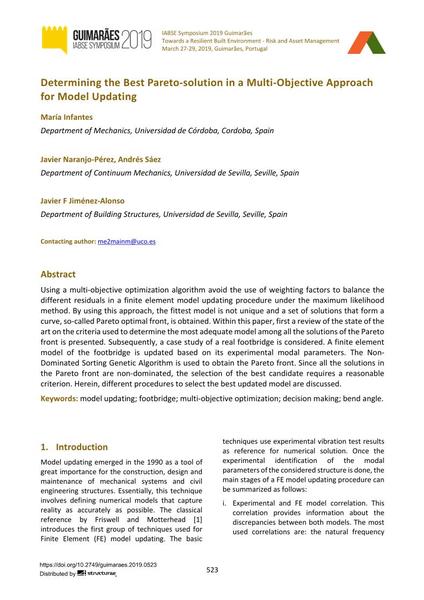Determining the Best Pareto-solution in a Multi-Objective Approach for Model Updating

|
|
|||||||||||
Bibliographic Details
| Author(s): |
María Infantes
(Department of Mechanics, Universidad de Córdoba, Cordoba, Spain)
Javier Naranjo-Pérez (Department of Continuum Mechanics, Universidad de Sevilla, Seville, Spain) Andrés Sáez Javier F. Jiménez-Alonso (Department of Building Structures, Universidad de Sevilla, Seville, Spain) |
||||
|---|---|---|---|---|---|
| Medium: | conference paper | ||||
| Language(s): | English | ||||
| Conference: | IABSE Symposium: Towards a Resilient Built Environment Risk and Asset Management, Guimarães, Portugal, 27-29 March 2019 | ||||
| Published in: | IABSE Symposium Guimarães 2019 | ||||
|
|||||
| Page(s): | 523-530 | ||||
| Total no. of pages: | 8 | ||||
| DOI: | 10.2749/guimaraes.2019.0523 | ||||
| Abstract: |
Using a multi-objective optimization algorithm avoid the use of weighting factors to balance the different residuals in a finite element model updating procedure under the maximum likelihood method. By using this approach, the fittest model is not unique and a set of solutions that form a curve, so-called Pareto optimal front, is obtained. Within this paper, first a review of the state of the art on the criteria used to determine the most adequate model among all the solutions of the Pareto front is presented. Subsequently, a case study of a real footbridge is considered. A finite element model of the footbridge is updated based on its experimental modal parameters. The Non- Dominated Sorting Genetic Algorithm is used to obtain the Pareto front. Since all the solutions in the Pareto front are non-dominated, the selection of the best candidate requires a reasonable criterion. Herein, different procedures to select the best updated model are discussed. |
||||
| Keywords: |
footbridge decision making model updating multi-objective optimization bend angle
|
||||
